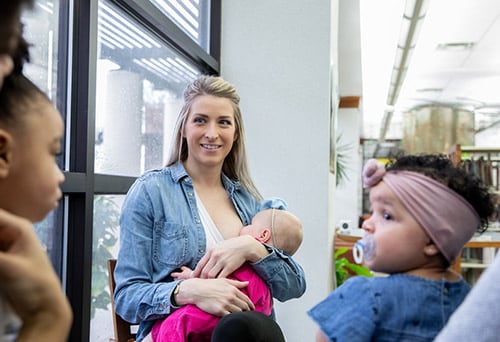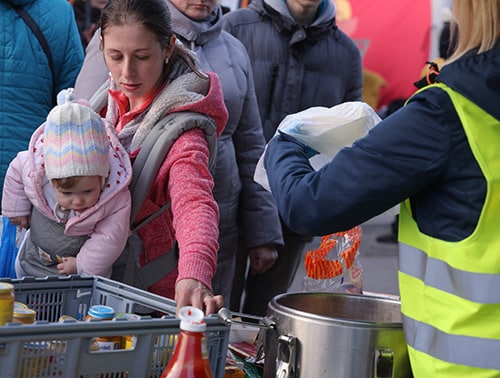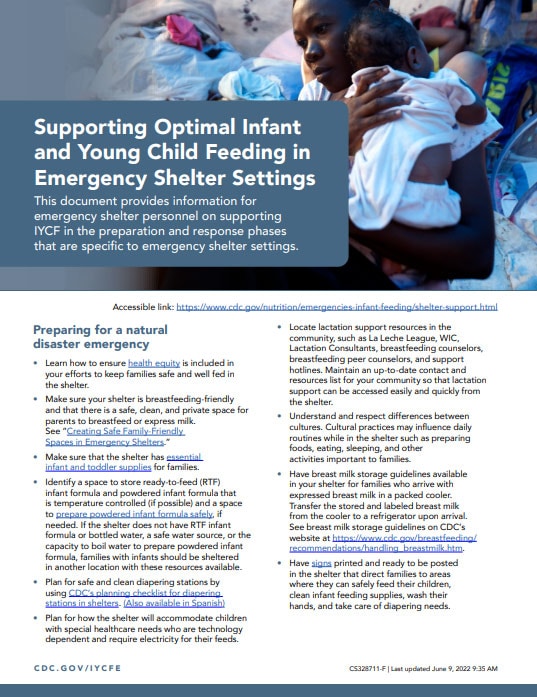Supporting Optimal Infant and Young Child Feeding in Emergency Shelter Settings
This document provides information for emergency shelter personnel on supporting IYCF in the preparation and response phases that are specific to emergency shelter settings.
Preparing for a natural disaster emergency
- Learn how to ensure health equity is included in your efforts to keep families safe and well fed in the shelter.
- Make sure your shelter is breastfeeding-friendly and that there is a safe, clean, and private space for parents to breastfeed or express milk. See “Creating Safe Family-Friendly Spaces in Emergency Shelters.”
- Make sure that the shelter has essential infant and toddler supplies for families.
- Identify a space to store ready-to-feed (RTF) infant formula and powdered infant formula that is temperature controlled (if possible) and a space to prepare powdered infant formula safely, if needed. If the shelter does not have RTF infant formula or bottled water, a safe water source, or the capacity to boil water to prepare powdered infant formula, families with infants should be sheltered in another location with these resources available.
- Plan for safe and clean diapering stations by using CDC’s planning checklist for diapering stations in shelters. [PDF-567KB] (Also available in Spanish [PDF-136KB])
- Plan for how the shelter will accommodate children with special healthcare needs who are technology dependent and require electricity for their feeds.
- Locate lactation support resources in the community, such as La Leche League, WIC, Lactation Consultants, breastfeeding counselors, breastfeeding peer counselors, and support hotlines. Maintain an up-to-date contact and resources list for your community so that lactation support can be accessed easily and quickly from the shelter.
- Understand and respect differences between cultures. Cultural practices may influence daily routines while in the shelter such as preparing foods, eating, sleeping, and other activities important to families.
- Have breast milk storage guidelines available in your shelter for families who arrive with expressed breast milk in a packed cooler. Transfer the stored and labeled breast milk from the cooler to a refrigerator upon arrival. See breast milk storage guidelines on CDC’s website at https://www.cdc.gov/breastfeeding/recommendations/handling_breastmilk.htm
- Have signage printed and ready to be posted in the shelter that direct families to areas where they can safely feed their children, clean infant feeding supplies, wash their hands, and take care of diapering needs.
During a natural disaster emergency

- Make pregnant and lactating women a priority group for access to food and water, safe shelter, healthcare, lactation support, and psychosocial support.
- Keep families together in the shelter and located in an area where they feel safe.
- Conduct a Rapid Needs assessment for IYCF-E with all families that includes information about how they are feeding their infants and children. Ask families what kind of feeding support or feeding related items they may need.
- Never routinely distribute infant formula to all families with infants in the event of a natural disaster. Distributing infant formula to all breastfeeding families can send an incorrect message to families that their breast milk is not enough or not safe during an emergency. Conducting a Rapid Needs Assessment will help identify which families need infant formula. Families feeding infant formula should use ready-to-feed (RTF) infant formula when possible.
- Keep infant formula and related supplies out of view of people staying in the shelter to avoid unintentional promotion or marketing of these products.
- Provide education to families about infant formula feeding, infant formula preparation (if RTF infant formula is not available), and proper cleaning of infant feeding items.
- Families feeding infant formula should receive infant formula and the supplies needed to safely prepare it and clean infant feeding items, if appropriate, for as long as needed.
- For eligible families, encourage and facilitate enrollment in a long-term program such as the Special Supplemental Nutrition Program for Women, Infants, and Children (WIC).
- As the natural disaster situation continues, conduct additional feeding assessments as needed to ensure families receive continued support to feed their infants and young children. Remind families that they can ask staff for supplies, information, and support that they may need.
- Do not call for, accept, or distribute donations of powdered infant formula or toddler milks. Emergency supplies of infant formula should only be acquired by official relief organizations.
- If lactation support is not readily available, identify other breastfeeding families within the shelter that may be willing to serve as peer-support to a family in need.
- Encourage and support lactating women to continue to breastfeed throughout the emergency or displacement. Remind families that breastfeeding is the safest method of feeding and will help protect their baby from illness and infection. Breastfeeding can also provide parents and babies comfort and reduce stress. Explain that breastfeeding doesn’t require electricity or water, which may be lacking or unsafe during the emergency.
- Encourage families to breastfeed whenever and wherever they want to in the shelter (aside from a bathroom). If others in the shelter are not comfortable with breastfeeding in public spaces relocate them to another part of the shelter, away from families.
- Show families the areas of the shelter where they can:
- Breastfeed or express milk in private (not a bathroom), if desired
- Wash their hands, prepare foods, and clean infant feeding items that is separate from a bathroom
- Safely change infants and dispose of infant diapers that is separate from the infant feeding area
- Access safe drinking water
- Provide disposable cups for families to use with their infants and children, as well as cup feeding instructions. Bottles, nipples, and sippy cups are difficult to keep clean when safe water is limited or unavailable.

- If local and state provided infant feeding supplies become depleted, the state can submit a Resource Request Form to FEMA to request infant and toddler kits [PDF-767KB].
- Monitor for mental health concerns among families seeking shelter. Emergency situations can cause significant stress on families and may impact the caregiver-infant feeding relationship. Provide on-site services if possible or connect the family to follow-up care through referrals. Provide information about caring for children in disasters.
- Substance Abuse and Mental Health Services Administration’s (SAMHSA) Disaster Technical Assistance Center (DTAC) helps states, U.S. territories, tribes, and local entities deliver an effective mental health and substance use (behavioral health) response to disasters. Learn more about SAMHSA DTAC.
- Follow all state and local guidelines for safety in a public disaster shelter setting including, but not limited to, social distancing, sanitation, and prevention activities such as face mask coverings, hand hygiene, and disinfection guidelines and follow shelter protocols when an individual presents with symptoms of illness.
View Page In: PDF-7.0MB
Error processing SSI file

